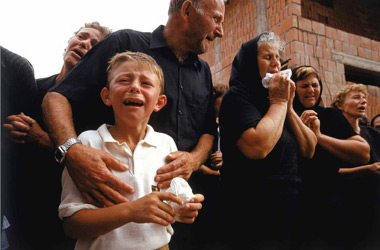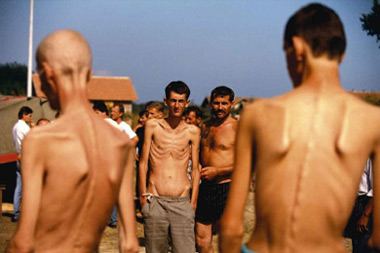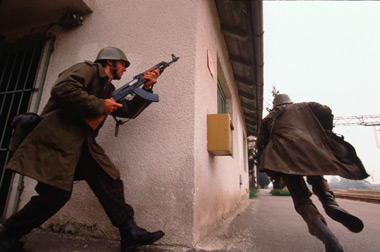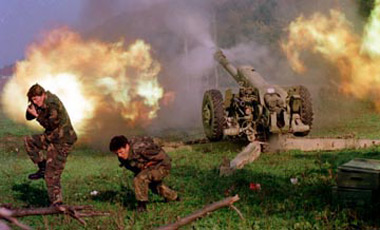 |
→ July 2004 Contents → Column
|
View from the Photo Desk
July 2004
|
 |
|
This month we feature a Q&A with Wade Goddard, curator of War Photo Limited, a new museum of war photography located in Dubrovnik, Croatia. Q: What is War Photo Limited about? A: War Photo is about the exhibition of war photography. It's about getting the message across that war is not quick, or clean, or fair or merciful, but brutal and unforgiving; it is cancer to a population. By exhibiting the work of these dedicated photographers who risk their lives to document the insanity that man inflicts upon man, we hope to bring attention to the reality of war to the public, and especially to those who have the power to authorize military action or deny its use. By asking the photographers to edit their own images we are not only able to share the photographer's view, but his or her experience. The politics become the photographer's, not the publisher's. I have great admiration and respect for their work and value their opinions and views highly. Q: Why establish War Photo Limited in Dubrovnik? A: We have a modern space in the center of Dubrovnik's old town. And while we are not London, New York or Paris, Dubrovnik is a unique place, one that is remembered by the hundreds of thousands of visitors who pass through here from all over the world. With fewer distractions in an idyllic place like Dubrovnik than in some mega-capital, our visitors spend time quietly taking in and contemplating the images that we are showing. And it's right on the doorstep of the country that saw Europe's worst conflict since World War II. We hope that those who visit War Photo Limited also remember what they see here the next time their leaders try to sanitize the face of war (and give us all that crap about "surgical strikes," "rules of war" and "limited collateral damage.") Q: Tell us a little about your background. A: Born in New Zealand, arrived in the former Yugoslavia in 1992 to try my hand at photojournalism, discovered my passion not only with photojournalism but with the region itself. Over the 10 or so years that I covered the events in the former Yugoslavia, I met and became friends with many of today's leading war photographers. Q: What was it like documenting the breakup of Yugoslavia as a photojournalist? A: Covering the breakup of the former Yugoslavia became my life force; it's what I had to do. I had to be there, to see it for myself, to feel it, to try to understand it. The brutality, the death, the destruction. What leads a people to destroy another and themselves in the process? If we understood the answers to this and the consequences of armed conflict, perhaps our political leaders would try a little harder to avoid war. I guess I am still searching for those answers amongst the images. Q: What are you hoping to accomplish with this museum? A: We are hoping to become "the place" in the world where the war photographer can bring his message to the public, a place that not only bridges the gap between the public and the horror of war and conflict, but also establishes a relationship between the audience and the photographer. He is our eye on the world, the mirror of our present. We must trust him if we are to trust his images. War Photo Limited offers an avenue for the public to support the work of this dedicated group and to learn more about them and the importance of their work. Q: Is there anything else that you would like to share with our readers? A: Lots. Our present exhibit is "A Decade of War" - featuring "Blood and Honey" by Ron Haviv. It runs from Sept. 2003 to July 20, 2004 and from Sept. 20 to Dec. 2004. The exhibit is a group show from 10 world-renowned photojournalists who covered the 10 years of war in the former Yugoslavia, from the wars in Croatia and Bosnia to the Kosovo conflict and the unrest in neighboring Macedonia. The main feature of the show is the photo exhibit, "Blood and Honey," by photographer Ron Haviv, Agency VII. Ron's 61-print exhibit covers the fall of Vukovar, Croatia, in 1991; the ethnic cleansing of Bosnia; the Sarajevo detention camps; the ethnic conflict in Kosovo; the bombing and the flight of the refugees; ending with the civil unrest in Macedonia. Ron is a contract photographer for Newsweek and has published two books of his work from both the former Yugoslavia and Afghanistan.
The remainder of the show is a combination of prints and slide shows on plasma monitors made by nine photojournalists whose work in the Balkans is recognized worldwide: - Jon Jones, former Magnum photographer, looks at Croatia and Sarajevo as well as concentrating on the battle in Mostar between Croats and Bosnian forces. Jon's last show looks at the people from the region and what they went through during the war. - Christopher Morris, Agency VII, a 15-war veteran, takes a close look at the brutal and graphic face of death. Chris's images of the victims of war from Croatia and Bosnia are chilling.
- Noel Quidu, agency Gamma, Paris, takes a general look at the wars in Croatia and Bosnia (this show was seen at the Photojournalist Festival in Perpignan in 2000). Noel also has a reportage of the Belgrade Revolution that saw riots in the city center and the taking of the parliament building in 2000. - Jan Grarup, agency Rapho, Paris, covers in black-and-white the Kosovar exodus to northern Albania during the American bombing campaign of Serbia in 1999 and their return home shortly afterwards. - Claus Bjorn Larsen, Berlingska Tidende, Denmark, also covers the Kosovar exodus and their return. Both Claus' and Jan's World Press Photo award-winning work from Kosovo is on display.
- Andrew Testa, Panos Pictures, U.K., exhibits his World Press Photo award-winning story from postwar Kosovo, "Serb Train," about a heavily-guarded train that provides the only safe way for Serbs and Roma to travel through Albanian-dominated parts of Kosovo. - Darko Bandic, AP, Croatia, looks at the wars in the former Yugoslavia, with a closer view of the Macedonian unrest in 2001. Darko also explores the effects of the Bosnian war 10 years later.
- Yannis Behrakis, Reuters, Greece, exhibits his award-winning selections from the Kosovo conflict in 1998 and 1999. His photographs won him a World Press Photo award, Fuji European News Photographer of the Year award and the Overseas Press Club award. - Srdjan Ilic, AP, Serbia, looks at the war in Kosovo. His access to the Serbian security forces gives us an insight into the Serbs of Kosovo. The show is also accompanied by several projections: Haviv's multimedia presentation of his book, "Blood and Honey"; "Vivisect," which explores Serbian reaction to the "Blood and Honey" exhibit; and "Eyes of the World," examining the act of witnessing war. Our upcoming exhibit this summer, from July 25 to Sept. 17, will be "WAR by VII: USA.AFGHANISTAN.IRAQ." This exhibit was first seen at the ICP in New York (titled "WAR IN IRAQ: The Coordinates of Conflict") and we have the honor of being the first to hold this exhibit in Europe. These breathtaking images from the members of Agency VII offer a deeper insight into the events of Sept 11th, its immediate aftermath and the response in both Afghanistan and Iraq. The exhibit, made up of 53 large-format prints from their award-winning book, "WAR," will be accompanied by slide shows on plasma monitors and presentations from members of the group. One of our other activities is the sale of limited-edition prints from both our current and upcoming exhibits. The prints are all certificated, signed and hand-numbered by the photographer. They are available at both the museum's Exhibition Center and on our Website: www.warphotoltd.com.
© Roger Richards
|
|
Back to July 2004 Contents |
|




